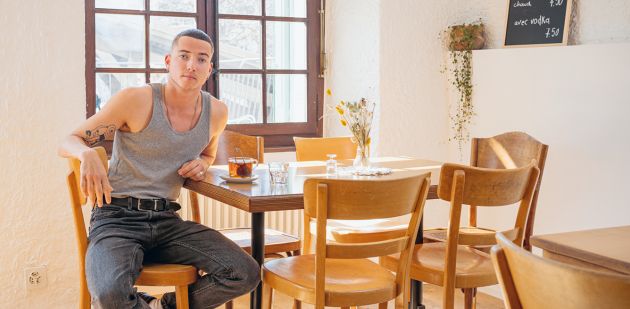Léon Salin now has a torso thanks to the mastectomy he had last year, and is taking testosterone so that his body aligns with the gender he identifies with the most.

“I wasn't born in the wrong body, but in the wrong society,” says Léon, 23. He feels his transition not as a break, but as a continuity. “Sometimes I have the feeling that I’m expected to say that I never felt good in my body, that I’ve always had a problem with the gender I was assigned at birth. That’s not true. It wasn’t until I was 20 that I realised that I was a man. I don’t deny what I was as a child or teen.”
That’s when living with the gender he was assigned at birth became deeply problematic. “For two years, it was very difficult for me to leave the house. I felt a great deal of dysphoria about my breasts.” Léon found support with organisations such as Le Refuge, in Geneva, before starting to work with a psychologist, whom he still sees to this day. Six months later, he had his first appointment with an endocrinologist.
“I wanted to take the highest possible dose of testosterone. They didn’t give it to me immediately. It was tough for me. I felt I was being patronised.”
At first testosterone injections are given every 10 weeks. Léon will take this treatment his entire life, but injections will gradually become less frequent. The first few days of treatment were still difficult for Léon, as the changes did not come as quickly as he had hoped. “Accepting the latency was a real challenge. To keep myself going and measure the changes, I took pictures of myself and recorded my voice every week.” As the days went by, he saw his body change in terms of the distribution of body mass; his hair became thicker, and his voice got deeper. He quickly stopped menstruating.
To preserve his potential fertility, despite the hormone intake, Léon opted to freeze 14 oocytes. “At age 19, it was hard for me to come to a decision about becoming a father one day. So I decided to have an operation to preserve gametes.”
Along with taking hormones, Léon wanted to have his breasts surgically removed. “The mastectomy was the key step in my transition, but also the most complicated.” The first hurdle was health insurance, which initially refused to pay for his torsoplasty. Then came complications with the operation itself and a lengthy recovery, which included wearing a compression garment for a month. “Today, I am delighted with the result. The scar follows the contour of the nipples and is therefore completely invisible. The operation has changed my life.”
Léon documented his transition on social networks. His Instagram account popularised him as transgender – a paradox because all he wanted was to be recognised as a man. Fortunately, Léon can easily pass as a man. That is probably why he has no problem displaying old pictures of himself or sometimes wearing a dress. “I reject the idea of grieving. I’m still the same person, in the same body, just in a form that is closer to how I feel.”